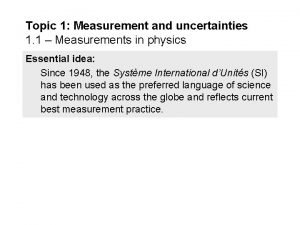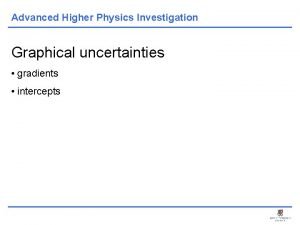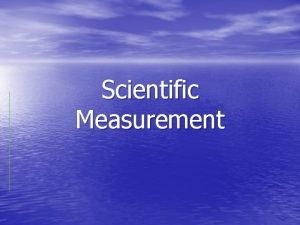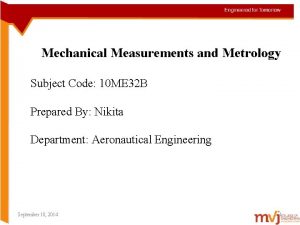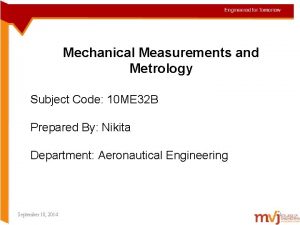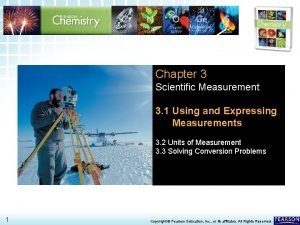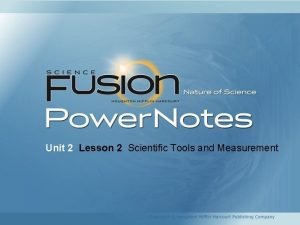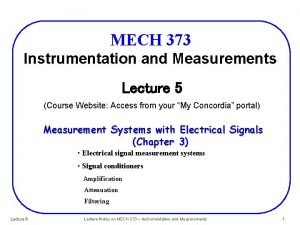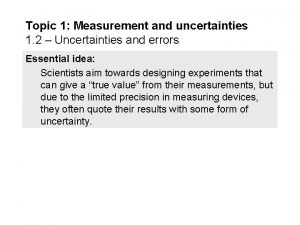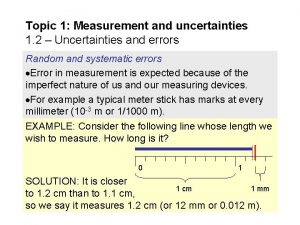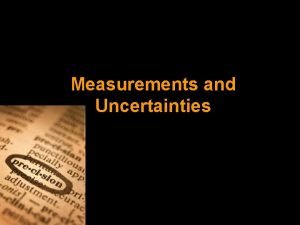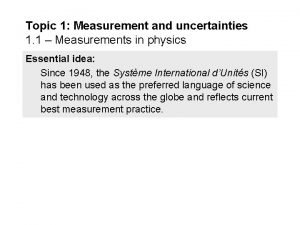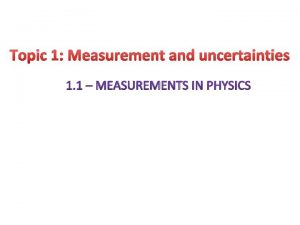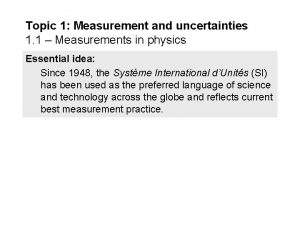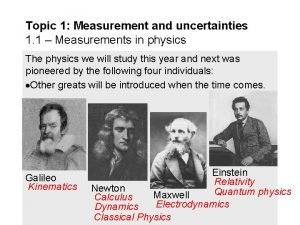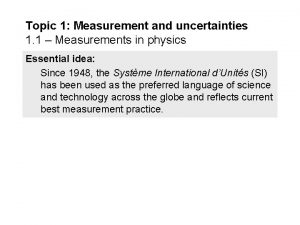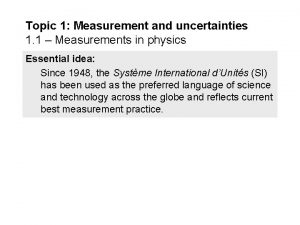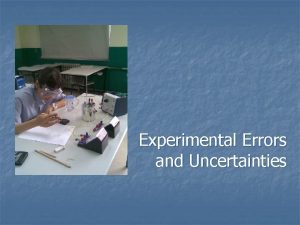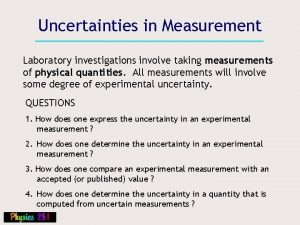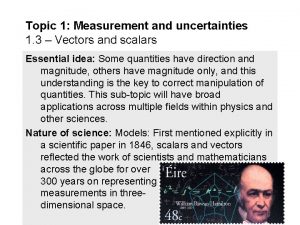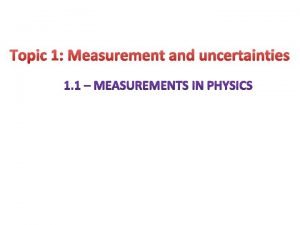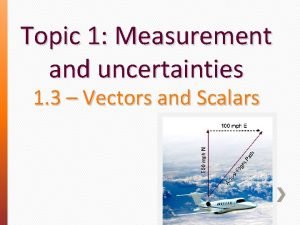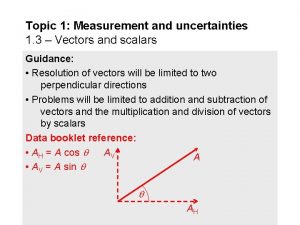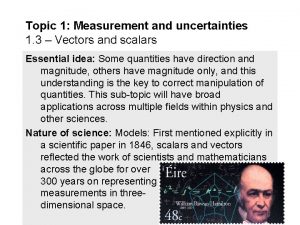Topic 1 Measurement and uncertainties 1 1 Measurements




























- Slides: 28

Topic 1: Measurement and uncertainties

1. 1 – Measurements in physics Essential idea: Since 1948, the Système International d’Unités (SI) has been used as the preferred language of science and technology across the globe and reflects current best measurement practice. Nature of science: (1) Common terminology: Since the 18 th century, scientists have sought to establish common systems of measurements to facilitate international collaboration across science disciplines and ensure replication and comparability of experiments. (2) Improvement in instrumentation: Improvement in instrumentation, such as using the transition of cesium-133 atoms for atomic clocks, has led to more refined definitions of standard units. (3) Certainty: Although scientists are perceived as working towards finding “exact” answers, there is unavoidable uncertainty in any measurement.

1. 2 – Uncertainties and errors Essential idea: Scientists aim towards designing experiments that can give a “true value” from their measurements, but due to the limited precision in measuring devices, they often quote their results with some form of uncertainty. Nature of science: Uncertainties: “All scientific knowledge is uncertain. When the scientist tells you he does not know the answer, he is an ignorant man. When he tells you he has a hunch about how it is going to work, he is uncertain aparamount importance, in order to make progress, that we recognize this ignorance and this doubt. Because we have the doubt, we then propose looking in new directions for new ideas. ” – Feynman, Richard P. 1998. The Meaning of It All: Thoughts of a Citizen-Scientist. Reading, Massachusetts, USA. Perseus. P 13.

1. 3 – Vectors and Scalars Essential idea: Some quantities have direction and magnitude, others have magnitude only, and this understanding is the key to correct manipulation of quantities. This sub-topic will have broad applications across multiple fields within physics and other sciences. Nature of science: Models: First mentioned explicitly in a scientific paper in 1846, scalars and vectors reflected the work of scientists and mathematicians across the globe for over 300 years on representing measurements in threedimensional space.

Topic 2: Mechanics

2. 1 – Motion Essential idea: ▪ Motion may be described analysed by the use of graphs and equations. Nature of science: ▪ Observations: The ideas of motion are fundamental to many areas of physics, providing a link to the consideration of forces and their implication. The kinematic equations for uniform acceleration were developed through careful observations of the natural world. 2. 2 – Forces Essential idea: ▪ Classical physics requires a force to change a state of motion, as suggested by Newton in his laws of motion. Nature of science: ▪ (1) Using mathematics: Isaac Newton provided the basis for much of our understanding of forces and motion by formalizing the previous work of scientists through the application of mathematics by inventing calculus to assist with this. ▪ (2) Intuition: The tale of the falling apple describes simply one of the many flashes of intuition that went into the publication of Philosophiæ Naturalis Principia Mathematica in 1687.

2. 3 – Work, energy, and power Essential idea: ▪ The fundamental concept of energy lays the basis upon which much of science is built. Nature of science: ▪ Theories: Many phenomena can be fundamentally understood through application of theory of conservation of energy. Over time, scientists have utilized this theory both to explain natural phenomena and, more importantly, to predict the outcome of previously unknown interactions. The concept of energy has evolved as a result of recognition of the relationship between mass and energy. 2. 4 – Momentum and impulse Essential idea: ▪ Conservation of momentum is an example of a law that is never violated. Nature of science: ▪ The concept of momentum and the principle of momentum conservation can be used to analyse and predict the outcome of a wide range of physical interactions, from macroscopic motion to microscopic collisions.

Topic 3: Thermal physics

3. 1 – Thermal concepts Essential idea: ▪ Thermal physics deftly demonstrates the links between the macroscopic measurements essential to many scientific models with the microscopic properties that underlie these models. Nature of science: ▪ Evidence through experimentation: Scientists from the 17 th and 18 th centuries were working without the knowledge of atomic structure and sometimes developed theories that were later found to be incorrect, such as phlogiston and perpetual motion capabilities. Our current understanding relies on statistical mechanics providing a basis for our use and understanding of energy transfer in science. 3. 2 – Modelling a gas Essential idea: ▪ The properties of ideal gases allow scientists to make predictions of the behaviour of real gases. Nature of science: ▪ Collaboration: Scientists in the 19 th century made valuable progress on the modern theories that form the basis of thermodynamics, making important links with other sciences, especially chemistry. The scientific method was in evidence with contrasting but complementary statements of some laws derived by different scientists. Empirical and theoretical thinking both have their place in science and this is evident in the comparison between the unattainable ideal gas and real gases.

Topic 4: Waves

4. 1 – Oscillations Essential idea: ▪ A study of oscillations underpins many areas of physics with simple harmonic motion (SHM) a fundamental oscillation that appears in various natural phenomena. Nature of science: ▪ Models: Oscillations play a great part in our lives, from the tides to the motion of the swinging pendulum that once governed our perception of time. General principles govern this area of physics, from water waves in the deep ocean or the oscillations of a car suspension system. This introduction to the topic reminds us that not all oscillations are isochronous. However, the simple harmonic oscillator is of great importance to physicists because all periodic oscillations can be described through the mathematics of simple harmonic motion.

4. 2 – Traveling waves Essential idea: ▪ There are many forms of waves available to be studied. A common characteristic of all travelling waves is that they carry energy, but generally the medium through which they travel will not be permanently disturbed. Nature of science: ▪ Patterns, trends and discrepancies: Scientists have discovered common features of wave motion through careful observations of the natural world, looking for patterns, trends and discrepancies and asking further questions based on these findings. 4. 3 – Wave characteristics Essential idea: ▪ All waves can be described by the same sets of mathematical ideas. Detailed knowledge of one area leads to the possibility of prediction in another. Nature of science: ▪ Imagination: It is speculated that polarization had been utilized by the Vikings through their use of Iceland Spar over 1300 years ago for navigation (prior to the introduction of the magnetic compass). Scientists across Europe in the 17 th– 19 th centuries continued to contribute to wave theory by building on theories and models proposed as our understanding developed.

4. 4 – Wave behavior Essential idea: ▪ Waves interact with media and each other in a number of ways that can be unexpected and useful. Nature of science: ▪ Competing theories: The conflicting work of Huygens and Newton on their theories of light and the related debate between Fresnel, Arago and Poisson are demonstrations of two theories that were valid yet flawed and incomplete. This is an historical example of the progress of science that led to the acceptance of the duality of the nature of light. 4. 5 – Standing waves Essential idea: ▪ When travelling waves meet they can superpose to form standing waves in which energy may not be transferred. Nature of science: ▪ Common reasoning process: From the time of Pythagoras onwards the connections between the formation of standing waves on strings and in pipes have been modelled mathematically and linked to the observations of the oscillating systems. In the case of sound in air and light, the system can be visualized in order to recognize the underlying processes occurring in the standing waves.

Topic 5: Electricity and magnetism

5. 1 – Electric fields Essential idea: ▪ When charges move an electric current is created. Nature of science: ▪ Modelling: Electrical theory demonstrates the scientific thought involved in the development of a microscopic model (behaviour of charge carriers) from macroscopic observation. The historical development and refinement of these scientific ideas when the microscopic properties were unknown and unobservable is testament to the deep thinking shown by the scientists of the time. 5. 2 – Heating effect of electric currents Essential idea: ▪ One of the earliest uses for electricity was to produce light and heat. This technology continues to have a major impact on the lives of people around the world. Nature of science: ▪ Peer review: Although Ohm and Barlow published their findings on the nature of electric current around the same time, little credence was given to Ohm. Barlow’s incorrect law was not initially criticized or investigated further. This is a reflection of the nature of academia of the time with physics in Germany being largely non-mathematical and Barlow held in high respect in England. It indicates the need for the publication and peer review of research findings in recognized scientific journals.

5. 3 – Electric cells Essential idea: ▪ Electric cells allow us to store energy in a chemical form. Nature of science: ▪ Long-term risks: Scientists need to balance the research into electric cells that can store energy with greater energy density to provide longer device lifetimes with the long-term risks associated with the disposal of the chemicals involved when batteries are discarded. 5. 4 – Magnetic effects of electric currents Essential idea: ▪ The effect scientists call magnetism arises when one charge moves in the vicinity of another moving charge. Nature of science: ▪ Models and visualization: Magnetic field lines provide a powerful visualization of a magnetic field. Historically, the field lines helped scientists and engineers to understand a link that begins with the influence of one moving charge on another and leads onto relativity.

Topic 6: Circular motion and gravitation

6. 1 – Circular motion Essential idea: ▪ A force applied perpendicular to a body’s displacement can result in its circular motion. Nature of science: ▪ Observable universe: Observations and subsequent deductions led to the realization that the force must act radially inwards in all cases of circular motion. 6. 2 – Newton’s law of gravitation Essential idea: ▪ The Newtonian idea of gravitational force acting between two spherical bodies and the laws of mechanics create a model that can be used to calculate the motion of planets. Nature of science: ▪ Laws: Newton’s law of gravitation and the laws of mechanics are the foundation for deterministic classical physics. These can be used to make predictions but do not explain why the observed phenomena exist.

Topic 6: Circular motion and gravitation Atomic, nuclear and particle physics

7. 1 – Discrete energy and radioactivity Essential idea: ▪ In the microscopic world energy is discrete. Nature of science: ▪ Accidental discovery: Radioactivity was discovered by accident when Becquerel developed photographic film that had accidentally been exposed to radiation from radioactive rocks. The marks on the photographic film seen by Becquerel probably would not lead to anything further for most people. What Becquerel did was to correlate the presence of the marks with the presence of the radioactive rocks and investigate the situation further. 7. 2 – Nuclear reactions Essential idea: ▪ Energy can be released in nuclear decays and reactions as a result of the relationship between mass and energy. Nature of science: ▪ Patterns, trends and discrepancies: Graphs of binding energy per nucleon and of neutron number versus proton number reveal unmistakable patterns. This allows scientists to make predictions of isotope characteristics based on these graphs.

7. 3 – The structure of matter Essential idea: ▪ It is believed that all the matter around us is made up of fundamental particles called quarks and leptons. It is known that matter has a hierarchical structure with quarks making up nucleons, nucleons making up nuclei, nuclei and electrons making up atoms and atoms making up molecules. In this hierarchical structure, the smallest scale is seen for quarks and leptons (10 -18 m). Nature of science: ▪ (1) Predictions: Our present understanding of matter is called the standard model, consisting of six quarks and six leptons. Quarks were postulated on a completely mathematical basis in order to explain patterns in properties of particles. ▪ (2) Collaboration: It was much later that large-scale collaborative experimentation led to the discovery of the predicted fundamental particles.

Topic 8: Energy production

8. 1 – Energy sources Essential idea: ▪ The constant need for new energy sources implies decisions that may have a serious effect on the environment. The finite quantity of fossil fuels and their implication in global warming has led to the development of alternative sources of energy. This continues to be an area of rapidly changing technological innovation. Nature of science: ▪ Risks and problem-solving: Since early times mankind understood the vital role of harnessing energy and large-scale production of electricity has impacted all levels of society. Processes where energy is transformed require holistic approaches that involve many areas of knowledge. Research and development of alternative energy sources has lacked support in some countries for economic and political reasons. Scientists, however, have continued to collaborate and share new technologies that can reduce our dependence on non-renewable energy sources.

8. 2 – Thermal energy transfer Essential idea: ▪ For simplified modelling purposes the Earth can be treated as a black-body radiator and the atmosphere treated as a grey-body. Nature of science: ▪ Simple and complex modelling: The kinetic theory of gases is a simple mathematical model that produces a good approximation of the behaviour of real gases. Scientists are also attempting to model the Earth’s climate, which is a far more complex system. Advances in data availability and the ability to include more processes in the models together with continued testing and scientific debate on the various models will improve the ability to predict climate change more accurately.

Option D: Astrophysics

D. 1 – Stellar quantities Essential idea: ▪ One of the most difficult problems in astronomy is coming to terms with the vast distances in-between stars and galaxies and devising accurate methods for measuring them. Nature of science: ▪ Reality: The systematic measurement of distance and brightness of stars and galaxies has led to an understanding of the universe on a scale that is difficult to imagine and comprehend.

D. 2 – Stellar characteristics and stellar evolution Essential idea: ▪ A simple diagram that plots the luminosity versus the surface temperature of stars reveals unusually detailed patterns that help understand the inner workings of stars. Stars follow well-defined patterns from the moment they are created out of collapsing interstellar gas, to their lives on the main sequence and to their eventual death. Nature of science: ▪ Evidence: The simple light spectra of a gas on Earth can be compared to the light spectra of distant stars. This has allowed us to determine the velocity, composition and structure of stars and confirmed hypotheses about the expansion of the universe.

D. 3 – Cosmology Essential idea: ▪ The Hot Big Bang model is a theory that describes the origin and expansion of the universe and is supported by extensive experimental evidence. Nature of science: ▪ Occam’s Razor: The Big Bang model was purely speculative until it was confirmed by the discovery of the cosmic microwave background radiation. The model, while correctly describing many aspects of the universe as we observe it today, still cannot explain what happened at time zero.
 Measurement topic
Measurement topic Percentage uncertainty
Percentage uncertainty Higher physics uncertainties
Higher physics uncertainties Advanced higher physics uncertainties
Advanced higher physics uncertainties Broad and specific topic examples
Broad and specific topic examples Tapic about internet
Tapic about internet Gr 11 map
Gr 11 map Measurements equivalents and adjustments
Measurements equivalents and adjustments Chapter 2 measurements and calculations
Chapter 2 measurements and calculations Force and torque measurements
Force and torque measurements Ee8403 measurements and instrumentation
Ee8403 measurements and instrumentation Temperature is an anthropometric measurement
Temperature is an anthropometric measurement Vital signs and body measurements quiz
Vital signs and body measurements quiz Angle measures and segment lengths
Angle measures and segment lengths Orthostatic vitals positive
Orthostatic vitals positive Vital signs and anthropometric measurements:
Vital signs and anthropometric measurements: Measurement uncertainty
Measurement uncertainty Pharmaceutical measurements and calculations
Pharmaceutical measurements and calculations Working principle of tool makers microscope
Working principle of tool makers microscope Metrology and measurements subject code
Metrology and measurements subject code Tablespoon abbreviation
Tablespoon abbreviation Percent error example
Percent error example Pharmaceutical measurements
Pharmaceutical measurements Vector quantities measure
Vector quantities measure Using and expressing measurements
Using and expressing measurements Measurements and scientific tools lesson 2
Measurements and scientific tools lesson 2 Weights and measure training
Weights and measure training Metric, apothecary and household conversion chart
Metric, apothecary and household conversion chart Instrumentation and measurements
Instrumentation and measurements
